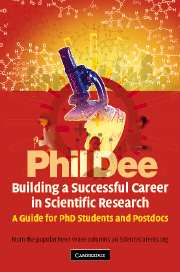Book contents
- Frontmatter
- Contents
- Foreword
- Preface
- PART I The first couple of years
- PART II The end of the beginning
- PART III The transition to post-doctoral research
- 10 From graduate student to post-doc
- 11 Collaboration and visiting other labs
- 12 Supervising students in the lab
- 13 Teaching
- 14 Writing grant proposals and fellowship applications
- PART IV Making it in science
- Epilogue
- Web-links
- Index
14 - Writing grant proposals and fellowship applications
Published online by Cambridge University Press: 05 June 2012
- Frontmatter
- Contents
- Foreword
- Preface
- PART I The first couple of years
- PART II The end of the beginning
- PART III The transition to post-doctoral research
- 10 From graduate student to post-doc
- 11 Collaboration and visiting other labs
- 12 Supervising students in the lab
- 13 Teaching
- 14 Writing grant proposals and fellowship applications
- PART IV Making it in science
- Epilogue
- Web-links
- Index
Summary
We all know that the best form of post-doc funding is a fellowship – in theory, your passport to a permanent career as a scientist. That is, if you take full advantage of the opportunity and don't experience an extended run of bad luck. But, even if you believe that you have a scientifically achievable idea that is of international importance, knowing whether now is the right time to apply for a fellowship often leaves post-docs in a quandary. Of course, you have to keep in mind that most fellowships have eligibility criteria, including an upper age limit or maximum number of years of post-doc experience. But, if you apply too soon, you'll probably not even be short-listed. In this context, I guess ‘too soon’ really means applying before you have accumulated enough high-impact publications. Let's face it, papers aren't everything, but without them all the scientific potential in the world won't get you very far.
So, if your publications list is looking a little sparse right now, why go to all that bother? Making the application could easily wipe out a couple of weeks when you could be cracking on in the lab. You may be fortunate enough to still have an alternative: bide your time; hold your nerve. Going for another post-doc grant will give you at least another year to gather more papers before that fellowship deadline looms again.
- Type
- Chapter
- Information
- Building a Successful Career in Scientific ResearchA Guide for PhD Students and Postdocs, pp. 97 - 100Publisher: Cambridge University PressPrint publication year: 2006



